A time-lapse movie of the sky
Every six months, NASA’s Near-Earth Object Wide Field Infrared Survey Explorer (NEOWISE) creates an all-sky map, recording the location and brightness of hundreds of millions of objects. Now, with more than 10 years of all-sky data, astronomers currently have 18 all-sky maps from NEOWISE, with the 19th and 20th maps available in March 2023. These maps, when viewed in sequence, essentially create a time-lapse movie of the sky. Notably, the movie reveals distant objects changing position or brightness across a decade.
Amy Mainzer, principal investigator for NEOWISE at the University of Arizona, said:
If you go outside and look at the night sky, it might seem like nothing ever changes, but that’s not the case. Stars are flaring and exploding. Asteroids are whizzing by. Black holes are tearing stars apart. The universe is a really busy, active place.
WISE becomes NEOWISE
NASA launched WISE in 2009 to scan the entire sky and study objects beyond our solar system. To begin with, the spacecraft used infrared light to see everything from nearby stars to luminous galaxies in the distant universe. Then, when the coolant on WISE ran out, the mission ended, and NASA repurposed the telescope.
Now, the infrared detectors that can function without the coolant are used to track asteroids and other near-Earth objects (NEOs). Thus, WISE became NEOWISE. Presently, the infrared telescope continues to scan the sky every six months. NEOWISE has found many comets that now bear its name.

Finding brown dwarfs using movement
Researchers are using the movie of the sky to study brown dwarfs. Brown dwarfs are failed stars that didn’t have enough mass to start fusion and ignite. Brown dwarfs are dim objects found both throughout the galaxy and lurking close to our sun.
There are many brown dwarfs close to Earth, and they appear to move faster across the sky compared to more distant stars. So astronomers look for movement among the billions of objects in the catalog to find brown dwarfs. You can join in this search through Backyard Worlds: Planet 9. This project uses citizen scientists to look for moving objects that computer searches missed.
Astronomers have found about 200 brown dwarfs within 65 light-years of our sun in the original two maps. Additional maps from NEOWISE revealed another 60 brown dwarfs. The data from the maps also doubled the number of known Y-dwarfs. Y-dwarfs are the coldest brown dwarfs and form the boundary between brown dwarfs and planets such as Jupiter.
Movie of the sky shows star formation and black holes
One benefit of NEOWISE data is watching how stars form. NEOWISE’s infrared vision can see through the dust surrounding protostars. Protostars are dusty cocoons of hot gas that are forming stars. NEOWISE allows astronomers to conduct long-term surveys of protostars and watch early star formation.
Astronomers are also learning more about black holes. The original WISE survey discovered millions of supermassive black holes at the centers of distant galaxies. The new NEOWISE data has allowed astronomers to measure the disks around the distant black holes. These disks would otherwise be too small and distant to see.
As Peter Eisenhardt of JPL said:
We never anticipated that the spacecraft would be operating this long, and I don’t think we could have anticipated the science we’d be able to do with this much data.
Bottom line: The NEOWISE space telescope has been taking all-sky images for 12 years, creating a movie of the sky that astronomers can use to watch the changing cosmos.











